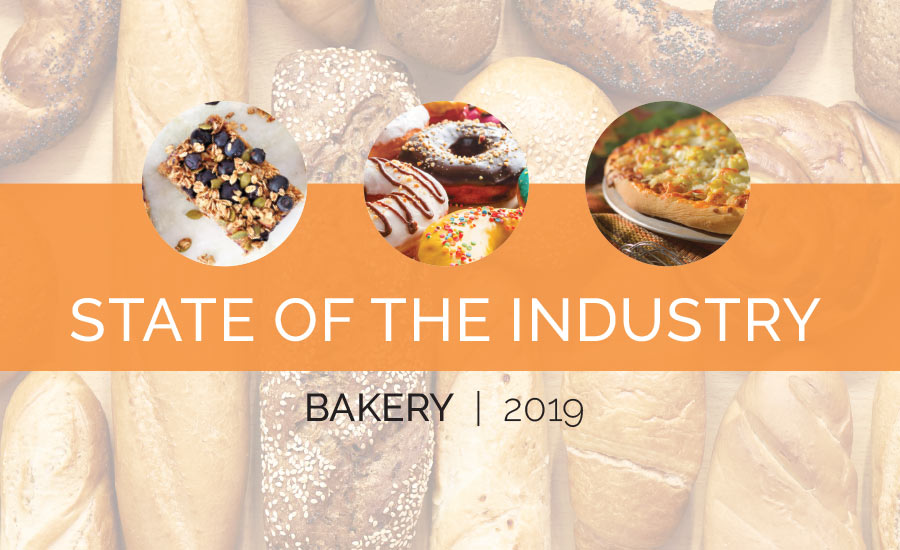State of the Industry 2019: Strategizing for success
The baking industry has strategic options at hand that can help foster growth

As presented in this annual “State of the Industry: Bakery” analysis, the U.S. bakery industry is responsible for $51.6 billion in annual sales, covering retail products across 10 vital categories: bars, breads, frozen breakfast, buns and rolls, cookies, desserts, pizza, snack cakes, sweet goods and tortillas. We live and work in a formidable industry that impacts nearly every American household on a daily basis. And we are continually looking for new opportunities to strategize for success and grow into our collective future.
Overview | Bread | Tortillas | Sweet Goods | Snack Cakes | Pizza | Desserts | Cookies | Buns & Rolls | Bars | Breakfast Products
Investing in the future
The American Bakers Association (ABA), Washington, D.C., recently invested in two research projects to help determine data-supported pathways toward future baking industry success: “The Power of Bakery,” developed in cooperation with the Food Marketing Institute (FMI) and Todd Hale, and “For the Love of Baked Goods… Millennials and Gen Z,” developed with The Center for Generational Kinetics.
“The recent ABA thought leadership projects—the ABA and FMI ‘Power of Bakery’ and the ‘Millennials and Gen Z’ survey—really showed the opportunity in front of the industry,” says Robb MacKie, president and CEO, ABA. “It is focusing on ‘healthy for you,’ freshness and the emotional connection consumers have with their bakery products. Unlike other food and beverage categories, bakery has a near universal household penetration with products consumers drive to retail outlets to buy.” The challenge is how to increase the times per week consumers buy bakery products.
While millennials and Generation Z display their own tendencies when it comes to engaging with bakery products (see the sidebar, “Millennials and Gen Z—future paths to bakery success”), the entire industry continues to shift in new directions. “The changing tastes of consumers is top-of-mind for bakers,” says MacKie. “With all the free-from, segmented dietary patterns and exposure to more global flavors and foods, it is a challenging environment. However, the ABA research shows that when you boil it all down, consumers care about great-tasting, fresh products that have a healthier profile. I see evidence in many bakery categories that bakers are making the needed adjustments to meet those changing consumer tastes.”
Policy matters
One of the top policy changes relates to disclosure of bioengineered (BE) ingredients on product labeling, with a current mandatory compliance date of January 1, 2022. “ABA is working to align the new BE Labeling & Disclosure with the new Nutrition Facts label in a way that makes sense and allows for efficient changeover of packaging,” says MacKie.
Another ongoing issue that bakers focused on is sustainability. “ABA has been a leader in promoting the industry to adopt more energy-efficient operations through the EPA Energy Star Partnership,” says MacKie. In March, ABA recognized 41 ABA member bakeries as 2018 Energy Star Certified manufacturing plants. Collectively, these bakeries reduced their energy bills by more than $400 million, saved more than 70 trillion Btus of energy, and achieved broad emissions reductions, including 4.5 million metric tons of greenhouse gas emissions.
Waste is another area of concern. “We are now gathering information to help bakers reduce their solid waste for inbound items, as well as product packaging,” says MacKie. “ABA has had a series of meetings with our European counterpart organization, and this has been a major topic of discussion. We believe that the industry could be part of a broader solution to sustainable packaging.”
Workforce development
Everyone across today’s baking industry is aware of the workforce development gap we face on an ongoing basis.
“The industry relies upon its nearly 800,000 skilled employees to produce, distribute and sell its products,” says MacKie. “With the supercharged economy and the tight labor market, bakers and suppliers are having to creatively and aggressively compete in order to keep that talented workforce and attract new talent. It is putting enormous pressure on the industry to look at all aspects of talent management, production schedules and distribution streams.”
ABA is responding to this situation by developing new thought leadership and communications around how to position the baking industry as a desirable career of choice, notes MacKie. “In addition, ABA is promoting federal workforce rules that allow for greater flexibility in managing the skilled talent and removing outdated workforce rules.”
Data from the “Workforce Gap in U.S. Commercial Baking: Trends, Challenges and Solutions” study, conducted by ABA and the American Society of Baking, shows that the industry faces significant turnover. “Bakers need to rethink their approaches to retention and recruitment,” says MacKie. “They also need to rethink how and where they are investing their limited capital expenditure dollars to allow them to retrain and retain key employees. ABA is working to provide critically important training for floor supervisors and those with the aptitude to become supervisors. This will help build highly engaged and high-performing operations teams.”
Bakeries across the U.S. face problems with filling open positions, notes Dave Van Laar, senior advisor to the president and CEO, ABA. “Some bakeries have reported more than 100 percent turnover in a year. Every new hire goes through a training process, and this training is costly. Creating a culture that encourages employees to see the full spectrum of opportunities in a baking career is challenging, but can be done. And it pays off.”
Bakeries must educate new employees on mandatory issues like lockout/tagout, HACCP, GMPs and local policies and procedures, notes Van Laar. But not all companies consider a basic introduction to baking as a required course. “In teaching the basics of baking, the knowledge gives the new employee a better sense of the industry and how their piece fits into the entire puzzle,” he says. “They can then see the importance of their work, take more ownership, and then see their potential path in the baking industry.”
Proper training not only helps bakeries retain employees, it can save money. “In some plants, eliminating just one bad batch per week could save up to $50,000 in dough costs,” says Van Laar. “Manufacturers can address this training need with in-house programs, as well as with time-tested and industry-approved programs such as ABA’s Cookie & Cracker Academy and Front Line Leadership Training program, produced in cooperation with Hearthside University. It’s important that courses are written by bakery members for bakery members. Those who wrote the courses understand the daily challenges faced on the production floor and can address them effectively.”
Overview | Bread | Tortillas | Sweet Goods | Snack Cakes | Pizza | Desserts | Cookies | Buns & Rolls | Bars | Breakfast Products
Looking for a reprint of this article?
From high-res PDFs to custom plaques, order your copy today!






